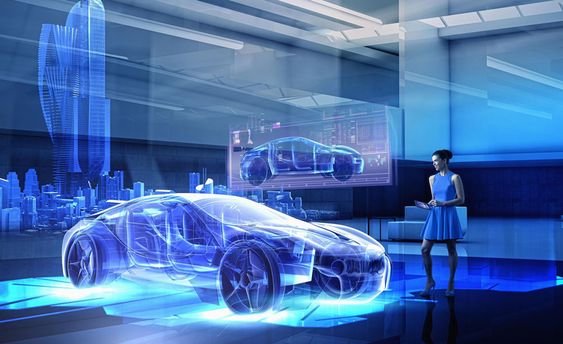
The automotive industry is undergoing a profound transformation, driven largely by advancements in Artificial Intelligence (AI). AI’s ability to process vast amounts of data, learn from patterns, and make intelligent decisions is revolutionizing how vehicles are designed, manufactured, and operated. AI is not only helping manufacturers optimize processes, but it’s also reshaping the driving experience through autonomous vehicles, predictive maintenance, and personalized features. In this comprehensive article, we will explore the numerous ways AI is used in the automobile industry and how it’s pushing the boundaries of innovation.
1. Autonomous Vehicles: The Future of Driving
Perhaps the most groundbreaking application of AI in the automotive industry is in the development of autonomous vehicles (AVs). Autonomous vehicles are capable of driving without human intervention, relying on AI systems that use sensors, cameras, radar, and LiDAR to perceive the surrounding environment and make driving decisions.
How AI Powers Autonomous Vehicles
Autonomous vehicles function by using a combination of AI algorithms, machine learning, deep learning, and computer vision. Here’s how AI plays a critical role in enabling self-driving cars:
- Perception: AI is used to interpret data from sensors like cameras, radar, and LiDAR. These sensors capture a real-time 3D map of the vehicle’s surroundings, which AI algorithms process to detect obstacles, pedestrians, other vehicles, road signs, and lane markings.
- Localization: AI helps autonomous vehicles understand their exact position on the road. Using a combination of GPS data, sensor fusion, and AI-driven algorithms, the vehicle can pinpoint its location with high accuracy, even in complex or changing environments.
- Path Planning: Once the vehicle has a clear understanding of its environment and location, AI is used to plan a safe and efficient route. This involves predicting the movement of other vehicles, pedestrians, and cyclists while following traffic rules.
- Decision Making: The most critical function of AI in autonomous vehicles is decision-making. The AI system must make real-time decisions about accelerating, braking, steering, and lane changes. It must also handle unexpected situations, such as sudden obstacles or changes in traffic conditions.
Companies like Tesla, Waymo, and Cruise are at the forefront of developing fully autonomous vehicles, and AI is the backbone of their systems.
Levels of Autonomy
The Society of Automotive Engineers (SAE) defines five levels of vehicle automation, ranging from Level 0 (no automation) to Level 5 (full automation):
- Level 1: Basic driver assistance, such as cruise control.
- Level 2: Partial automation, where the car can control both steering and acceleration/deceleration, but the driver must remain engaged.
- Level 3: Conditional automation, where the vehicle can handle most driving tasks but requires human intervention when needed.
- Level 4: High automation, where the vehicle can operate autonomously in specific conditions or environments.
- Level 5: Full automation, where the vehicle operates entirely without human intervention in all conditions.
At present, many companies are working toward Level 4 and 5 autonomy, with AI playing a crucial role in reaching these advanced levels of automation.
2. AI in Manufacturing: Smart Factories and Automation
AI is not just reshaping how vehicles operate but also how they are manufactured. Automotive manufacturers are increasingly turning to AI to optimize production processes, improve quality control, and increase efficiency.
Smart Factories and Industry 4.0
The concept of “Industry 4.0” refers to the fourth industrial revolution, where AI, IoT (Internet of Things), and big data analytics come together to create smart factories. In these factories, AI plays a central role in enabling automation, predictive maintenance, and quality assurance.
- Automation: AI-powered robots and machines are capable of performing repetitive and complex tasks with precision and speed. These robots can work alongside humans in a collaborative environment, enhancing productivity while reducing human error.
- Predictive Maintenance: One of the key applications of AI in manufacturing is predictive maintenance. AI analyzes data from sensors attached to machinery to predict when maintenance is needed, thereby preventing costly breakdowns and downtime. For example, AI can detect anomalies in the performance of production-line equipment, alerting technicians before a machine fails.
- Quality Control: AI is also used for quality control through computer vision. Cameras and AI algorithms can inspect parts and products for defects much faster and more accurately than human inspectors. This ensures that only high-quality components make it to the final assembly line.
- Supply Chain Optimization: AI helps manufacturers manage their supply chains more efficiently by predicting demand, optimizing inventory levels, and ensuring that parts are delivered on time. This reduces costs and ensures smooth operations across the board.
Major automakers such as BMW, Ford, and Volkswagen have implemented AI in their factories to streamline production and improve overall efficiency.
3. AI for Enhanced Driver Assistance Systems
While fully autonomous vehicles are still in development, AI-powered driver assistance systems are already making a significant impact. Advanced Driver Assistance Systems (ADAS) use AI to help drivers avoid accidents and make driving safer and more convenient.
Key Features of AI-Powered ADAS
- Adaptive Cruise Control: AI adjusts the vehicle’s speed based on the distance from the car ahead, maintaining a safe following distance without driver input.
- Lane-Keeping Assist: AI monitors lane markings and makes minor steering adjustments to keep the vehicle within its lane.
- Automatic Emergency Braking (AEB): AI analyzes data from sensors to detect an impending collision and automatically applies the brakes to prevent or mitigate the impact.
- Traffic Sign Recognition: AI-powered cameras detect and interpret traffic signs, alerting the driver to changes in speed limits, stop signs, or other important warnings.
- Blind-Spot Monitoring: AI analyzes the vehicle’s surroundings to detect other vehicles in the blind spot and provides alerts to the driver.
AI’s Role in Making ADAS Smarter
AI plays a critical role in processing and analyzing the data from sensors and cameras to make real-time decisions. With machine learning, ADAS systems can continuously improve over time by learning from different driving environments and situations. These systems are already widely available in vehicles from automakers like Toyota, Honda, and Audi, making driving safer and more convenient for millions of people.
4. Predictive Maintenance and AI-Driven Diagnostics
AI is also being used to improve vehicle maintenance and diagnostics. Traditional maintenance is often reactive, meaning repairs are made after a problem occurs. However, AI enables predictive maintenance, where potential issues are identified and addressed before they lead to breakdowns.
How Predictive Maintenance Works
AI-powered systems collect data from various sensors embedded in the vehicle, including engine performance, tire pressure, battery health, and more. Machine learning algorithms analyze this data to predict when a component is likely to fail or require maintenance. This allows for:
- Proactive Repairs: AI can detect small problems, like wear and tear on parts, before they become major issues, allowing drivers to schedule maintenance before a breakdown occurs.
- Cost Savings: By preventing unexpected breakdowns, predictive maintenance reduces costly repairs and avoids vehicle downtime, especially important for fleets and commercial vehicles.
- Extended Vehicle Lifespan: Regular, AI-driven maintenance helps to extend the lifespan of vehicles by ensuring that all components are functioning optimally.
For example, Tesla uses AI to monitor and diagnose its electric vehicles remotely. The system can update software and diagnose issues over-the-air, reducing the need for in-person service visits.
5. AI in Infotainment and Personalization
AI is also transforming in-car infotainment systems by making them more personalized and intuitive. Modern vehicles are increasingly connected, and AI is being used to enhance the in-car experience in several ways.
Personalized Infotainment
AI enables personalized infotainment systems that adapt to the preferences of individual drivers and passengers. Here are some of the key ways AI improves infotainment:
- Voice Recognition: AI-powered virtual assistants, like Amazon Alexa, Google Assistant, and Apple Siri, are integrated into vehicles to enable voice-activated commands. Drivers can use voice commands to control navigation, adjust settings, and access entertainment features without taking their hands off the wheel.
- Music and Content Recommendations: AI analyzes the driver’s listening habits and preferences to recommend music, podcasts, or other entertainment content that aligns with their tastes.
- Navigation and Traffic Prediction: AI-driven navigation systems provide real-time traffic updates and suggest the most efficient routes based on current road conditions. Some systems can even learn from a driver’s regular routes and make personalized route suggestions.
- Comfort Settings: AI can automatically adjust climate control, seat position, and ambient lighting based on driver preferences. Some systems even offer health and wellness features, such as AI-powered stress monitoring.
Manufacturers like Mercedes-Benz, BMW, and Audi are integrating AI-driven infotainment systems to provide a more engaging and personalized driving experience.
6. AI for Sustainability: Electric Vehicles and Energy Efficiency
As the automotive industry shifts towards sustainability, AI plays a key role in supporting the development and optimization of electric vehicles (EVs) and improving energy efficiency in traditional combustion engines.
AI in Electric Vehicles
Electric vehicles require smart energy management to optimize battery usage and extend driving range. AI helps achieve this through:
- Battery Management: AI algorithms monitor and optimize the charging and discharging cycles of EV batteries, ensuring they are used efficiently. This prolongs battery life and increases the vehicle’s range.
- Route Optimization: AI-driven navigation systems in EVs can suggest the most energy-efficient routes based on road conditions, traffic, and the availability of charging stations.
- Predictive Battery Health: AI can predict battery degradation and recommend optimal charging practices to ensure long-term performance.
Companies like Tesla and Rivian are leading the charge in using AI to improve the performance and efficiency of electric vehicles.
AI for Fuel Efficiency in Combustion Engines
AI is also helping to make traditional combustion engines more fuel-efficient by optimizing various engine parameters in real time. This reduces fuel consumption and lowers emissions, contributing to more sustainable transportation.
For instance, Bosch has developed AI-powered systems that optimize fuel injection and engine performance to reduce emissions and improve fuel economy.
7. AI for Vehicle-to-Everything (V2X) Communication
Another exciting application of AI in the automotive industry is in Vehicle-to-Everything (V2X) communication. V2X technology allows vehicles to communicate with each other (Vehicle-to-Vehicle or V2V) and with infrastructure (Vehicle-to-Infrastructure or V2I). AI plays a critical role in processing and analyzing the data exchanged between vehicles and infrastructure to enable safer and more efficient transportation.
Benefits of AI-Driven V2X Communication
- Accident Prevention: AI can analyze data from surrounding vehicles to predict potential collisions and warn drivers or autonomous systems to take corrective actions.
- Traffic Management: AI can optimize traffic flow by analyzing data from connected vehicles and adjusting traffic signals and road conditions in real time.
- Platooning: AI can enable vehicles to form platoons, where multiple vehicles follow each other closely in a coordinated manner, reducing air resistance and improving fuel efficiency.
- Pedestrian Safety: V2X communication, combined with AI, can help vehicles detect pedestrians and cyclists in their vicinity, reducing the risk of accidents.
Automakers like Audi and Toyota are already experimenting with AI-driven V2X communication systems.
Conclusion
Artificial Intelligence is fundamentally reshaping the automotive industry, touching every aspect of vehicle design, production, operation, and maintenance. From autonomous vehicles and predictive maintenance to AI-powered infotainment systems and smart manufacturing, AI is driving innovation at an unprecedented pace.
As AI technology continues to evolve, the automobile industry will likely see even more sophisticated applications, such as fully autonomous cars, smarter and more efficient manufacturing processes, and personalized driving experiences. The integration of AI with other emerging technologies, such as 5G, IoT, and blockchain, will only accelerate this transformation.
In conclusion, AI is not just enhancing the automotive industry—it’s revolutionizing it, paving the way for safer, more efficient, and more sustainable transportation solutions for the future.
ALSO READ: How Rivian Aims to Challenge Tesla in the EV Market







